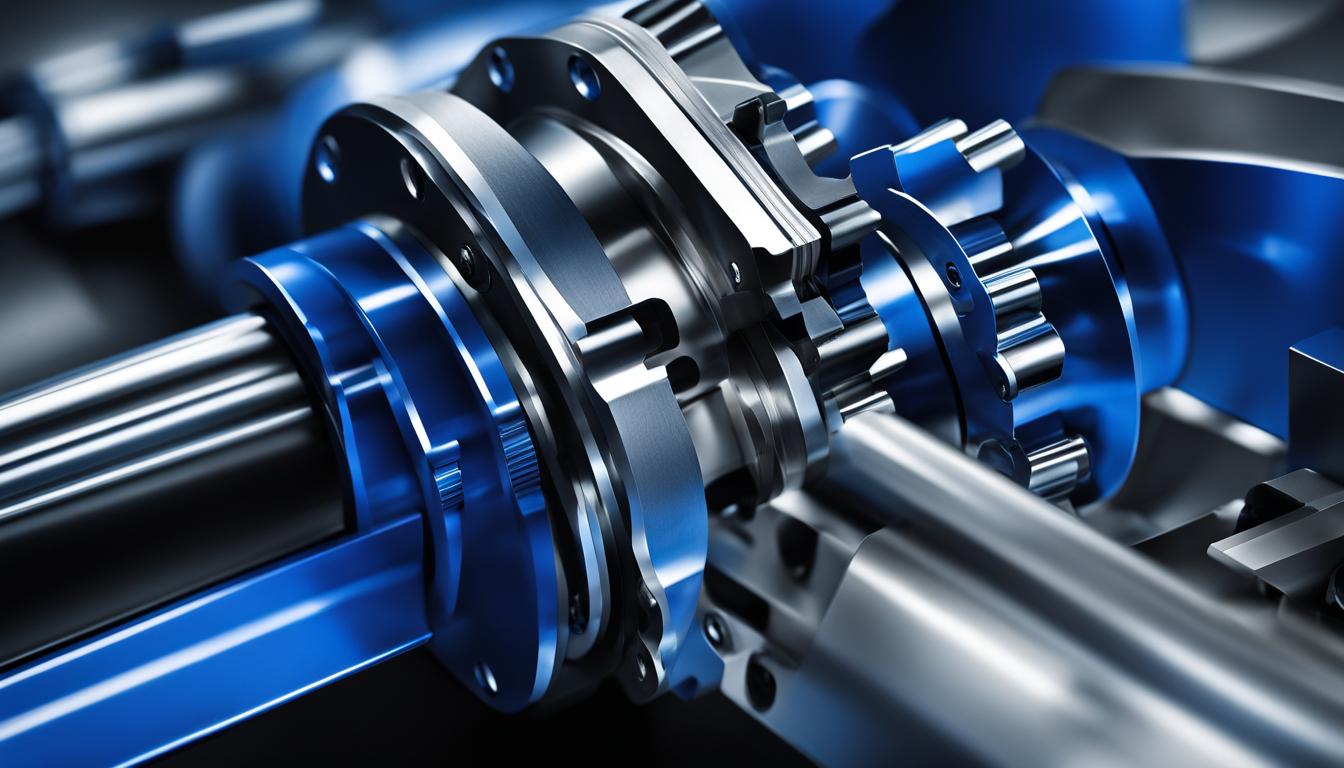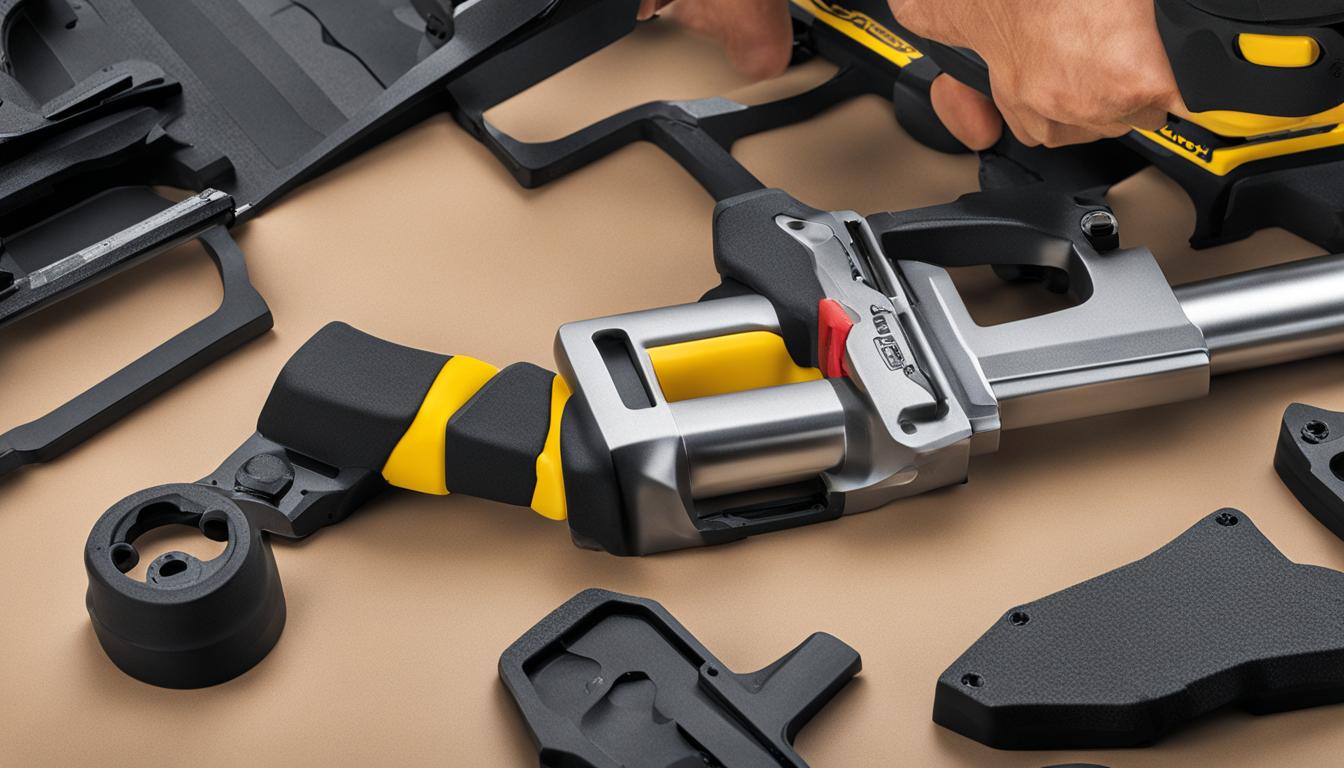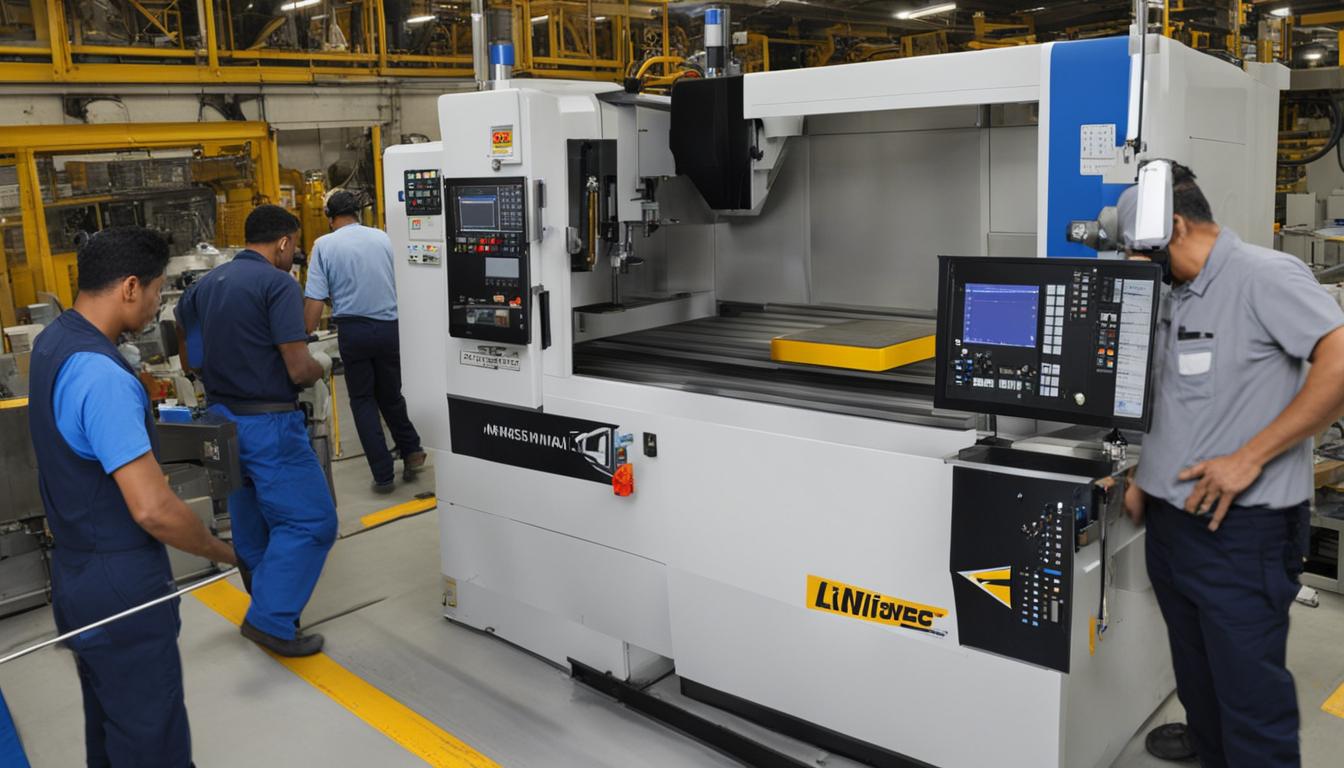A machine that is standing still costs money. In the machining sector, CNC machines often do not reach their full production potential. To prevent your CNC machine from standing idle, here are some effective tips to maximize productivity and minimize downtime.
- Standardize the raw material to enable faster product changeovers and reduce downtime.
- Implement a zero-point clamping system for quick and automated fixture changes.
- Explore automation solutions to increase spindle hours and productivity.
- Consider single-batch and multi-batch automation for continuous production and reduced downtime.
- Choose versatile grippers that can handle multiple product sizes without manual adjustments.
Standardize the Raw Material
Standardizing the raw material used in CNC machining can significantly reduce downtime and increase productivity. By standardizing the material, you can produce multiple product series from the same format, minimizing the need for frequent material changes and reducing setup time.
When the raw material is standardized, the operator can use the same fixture for different product series, enabling faster product changeovers. This eliminates the need for extensive adjustments and reduces downtime between production runs.
Standardizing the raw material not only streamlines the production process but also improves overall efficiency. With less time spent on material changes and setup, your CNC machine can focus on what it does best – machining high-quality parts.
Table: Benefits of Standardizing Raw Material
| Benefits | Description |
|---|---|
| Increase productivity | Produce multiple product series from the same format material, reducing setup time. |
| Reduce downtime | Minimize the need for frequent material changes and extensive adjustments, enabling faster product changeovers. |
| Streamline production process | Eliminate time spent on material changes and setup, allowing the CNC machine to focus on machining. |
Standardizing the raw material is a tried-and-tested method to optimize CNC machine operations. By implementing this practice in your manufacturing process, you can achieve greater efficiency, reduce downtime, and maximize productivity.
Implement a Zero-Point Clamping System
To ensure quick and efficient fixture changes on your CNC machine, implementing a zero-point clamping system is essential. This system allows for rapid and precise positioning of fixtures, enabling quick setup changes and reducing downtime.
A zero-point clamping system works by utilizing a set of standardized clamps and receivers mounted on the machining table. The clamps securely hold the fixtures in place while providing a high degree of repeatability. By incorporating a centralized clamping concept, the system allows for automated fixture changes, eliminating the need for manual adjustments and reducing setup time.
With a zero-point clamping system, operators can easily switch between different workpieces or product series, resulting in faster turnaround times and increased productivity. The automated fixture changes ensure consistent and accurate positioning, minimizing the risk of errors and improving overall machining quality.
Benefits of a Zero-Point Clamping System:
- Quick and precise fixture changes
- Reduced setup time and downtime
- Improved productivity and efficiency
- Enhanced machining quality and accuracy
- Flexibility to accommodate various workpieces and product series

Table: Comparison of Clamping Systems
| Clamping System | Setup Time | Fixture Change Time | Repeatability |
|---|---|---|---|
| Conventional Clamping | High | Long | Less precise |
| Zero-Point Clamping | Low | Short | Highly precise |
As shown in the comparison table, a zero-point clamping system offers significant advantages over conventional clamping methods. The reduced setup time and quick fixture changes result in improved efficiency and reduced downtime. The high repeatability of the system ensures consistent machining quality, enhancing overall productivity.
By implementing a zero-point clamping system, you can enhance the performance of your CNC machine and maximize its potential for continuous production. This solution is particularly beneficial for manufacturers dealing with frequent product changeovers or varying workpiece sizes.
CNC Machine Automation for Increased Spindle Hours
CNC machine automation is a game-changer when it comes to maximizing spindle hours and boosting productivity. By implementing automation solutions such as bar feed, pallet loading, and product loading, manufacturers can keep their CNC machines running continuously, minimizing downtime and maximizing output. Let’s explore some of the key automation strategies that can help achieve this.
Bar Feed Automation
Bar feed automation is a cost-effective way to streamline the production process, especially for turning machines. By automating the feeding of raw material into the machine, manufacturers eliminate the need for manual intervention and reduce downtime between production runs. This ensures that the CNC machine remains operational for longer periods, increasing spindle hours and overall efficiency.
Pallet and Product Loading Automation
Pallet and product loading automation takes CNC machine automation to the next level. With this solution, manufacturers can automate the loading and unloading of workpieces, allowing for continuous production without interruptions. By utilizing robotic systems or other automated mechanisms, the CNC machine can efficiently handle multiple product series, reducing changeover time and increasing spindle utilization.
| Automation Solution | Benefits |
|---|---|
| Bar Feed | Minimizes manual intervention, reduces downtime, increases spindle hours |
| Pallet and Product Loading | Enables continuous production, reduces changeover time, maximizes spindle utilization |
By implementing CNC machine automation solutions like bar feed and pallet loading, manufacturers can significantly improve spindle hours and overall productivity. These automation strategies not only reduce downtime but also enable continuous production and faster product changeovers. As technology continues to advance, it’s essential for manufacturers to embrace automation to stay competitive in the machining industry.
Single-Batch and Multi-Batch Automation
In order to maximize productivity and reduce downtime, CNC machine operators can implement both single-batch and multi-batch automation techniques. Single-batch automation involves automating the production process for one specific product series. This allows for continuous production of that particular product, resulting in decreased downtime and increased efficiency. By automating the single-batch process, operators can take advantage of the machine’s capabilities, ensuring that it runs at its full potential.
On the other hand, multi-batch automation takes it a step further by automating the production process for multiple product series. With multi-batch automation, CNC machines can produce different product formats continuously, 24/7. This eliminates the need for time-consuming product changeovers, resulting in even greater efficiency and reduced downtime.
To enable single-batch and multi-batch automation, it is crucial to equip the machining table with the necessary connections for control. This allows for seamless integration with the automation system and ensures smooth operation throughout the production process.
Benefits of Single-Batch and Multi-Batch Automation:
- Continuous production of one or multiple product series
- Reduced downtime due to automated processes
- Maximized machine efficiency and productivity
- Streamlined production workflows
In summary, implementing both single-batch and multi-batch automation techniques can significantly enhance the productivity of CNC machines. By automating the production process, operators can achieve continuous production, reduce downtime, and optimize machine efficiency. With the right infrastructure and control systems in place, CNC machines can operate at their full potential and deliver high-quality products consistently.
| Automation Technique | Key Features |
|---|---|
| Single-Batch Automation | – Automates production for one specific product series – Enables continuous production of the chosen product – Reduces downtime by eliminating product changeovers |
| Multi-Batch Automation | – Automates production for multiple product series – Allows for continuous production of different product formats – Eliminates the need for frequent product changeovers |
Choose Versatile Grippers
When it comes to preventing your CNC machine from standing idle, choosing the right grippers can make a significant difference. Versatile grippers are a must-have for maximizing productivity and minimizing downtime. These grippers are designed to handle a wide range of product sizes, allowing for flexibility in production.
A great option to consider is the self-controlled-adjusting gripper. This innovative gripper automatically adjusts to different product sizes, eliminating the need for manual adjustments. With a self-controlled-adjusting gripper, you can easily switch between different product series without wasting time on tool changes or reconfiguration.
By using versatile grippers, you can optimize your CNC machine’s efficiency and reduce the risk of downtime. With the ability to handle multiple product sizes, you can streamline your production process and minimize disruptions. Investing in versatile grippers is a smart choice for any CNC machine operator looking to maximize productivity and minimize idle time.

| Gripper Type | Benefits |
|---|---|
| Versatile Grippers | Handle a wide range of product sizes |
| Self-Controlled-Adjusting Gripper | Automatically adjusts to different product sizes |
Enable Continuous Production
To ensure uninterrupted productivity and reduce downtime, it is crucial to choose software that enables continuous production and the editing of multiple product series. This allows your CNC machine to keep running seamlessly, even after completing one program. By implementing the right software solutions, you can maximize efficiency and optimize the utilization of your machine.
Continuous production software enables you to seamlessly transition between different product series without any interruption in the machining process. It allows you to edit and modify programs on the go, ensuring that your CNC machine can handle multiple product jobs in a smooth and efficient manner. With this capability, you can easily adapt to changing production needs and minimize unnecessary downtime.
By investing in software that enables continuous production and the editing of multiple product series, you can significantly enhance the productivity of your CNC machine. It provides the flexibility and agility needed to meet the demands of various product requirements and optimize the utilization of your machine’s capabilities.
Table: Key Features of Software for Continuous Production
| Feature | Description |
|---|---|
| Program Editing | Allows for easy modification and customization of machining programs on the fly. |
| Seamless Transition | Enables smooth transition between different product series without interruptions. |
| Real-Time Monitoring | Provides real-time monitoring of machine performance and production status. |
| Optimized Scheduling | Optimizes production scheduling to minimize downtime and maximize efficiency. |
| User-Friendly Interface | Offers an intuitive and user-friendly interface for easy operation and programming. |
Focus on Single Pieces and Small Series
When it comes to maximizing efficiency and profitability, it’s important for CNC machine operators to focus on automating the production of single pieces and small series. These types of manufacturing runs often yield higher profit margins due to their specialized nature and higher demand. By automating the production process, you can ensure round-the-clock operation and faster delivery times.
Automation allows for continuous production, reducing downtime caused by lengthy product changeover times. With the ability to seamlessly transition from one product series to another, you can optimize your CNC machine’s productivity and minimize idle time. This not only improves your overall efficiency but also enhances your competitiveness in the market.
By implementing automation solutions for single pieces and small series, you can achieve higher output volumes with fewer manual interventions. This not only increases your machine’s spindle hours but also reduces the risk of errors and inconsistencies in the production process. You can rely on consistent, precise results that meet your customers’ expectations and drive customer satisfaction.
| Benefits of Focusing on Single Pieces and Small Series | |
|---|---|
| Higher profit margins | Automation allows for faster production and delivery, enabling you to command premium prices for specialized products. |
| Reduced downtime | By automating the production process, you can minimize idle time and maximize machine utilization. |
| Faster delivery times | Automation enables round-the-clock operation, allowing you to meet tight deadlines and deliver products more quickly. |
Whether you’re working on custom-made parts or small batches of specialized products, focusing on single pieces and small series can provide a significant boost to your bottom line. By harnessing the power of automation, you can optimize your CNC machine’s productivity, achieve higher profit margins, and deliver faster results to your customers.
Maintain Sufficient Tool Inventory
When it comes to preventing production loss and maximizing efficiency in your CNC machine operations, maintaining a sufficient tool inventory is crucial. Having an ample stock of tools ensures that you can accommodate multiple product series without experiencing unnecessary downtime due to tool breakage or damage.
By using the same tools as much as possible, you can minimize the need for unique tools per series, further streamlining your production process. This approach not only saves time but also reduces costs by eliminating the constant need to purchase new tools for each product series.
To effectively manage your tool inventory, it’s important to regularly assess and replenish your stock. Monitor tool usage and identify any high-wear or high-demand tools that may require additional quantities. By staying proactive in maintaining your tool inventory, you can prevent production delays and keep your CNC machine running smoothly.
Importance of Tool Inventory Management
Efficient tool inventory management is essential for maximizing productivity and preventing production loss. It ensures that you have the necessary tools readily available for various product series, allowing for uninterrupted production and minimizing the risk of machine downtime. With a well-maintained tool inventory, you can optimize your CNC machine operations and meet customer demands effectively.
By implementing a systematic approach to tool inventory management, you can track tool usage, identify potential shortages, and plan for timely replacements. Regular audits and assessments can help you identify any inefficiencies in your tool inventory management process and make necessary adjustments to improve your overall production efficiency.
In conclusion, maintaining a sufficient tool inventory is a critical aspect of preventing production loss and optimizing CNC machine operations. By strategically managing your tool stock and using the same tools as much as possible, you can minimize downtime, enhance productivity, and ensure smooth operations across multiple product series.
Implement Tool Life Management
To optimize tool usage and prevent machine shutdowns, implementing tool life management is essential. With the help of robot control, the machining process can be efficiently monitored and tool performance can be assessed. By calculating the production feasibility per tool, potential tool limitations can be identified in advance, minimizing the risk of production interruptions.
Tool life management involves closely monitoring and measuring the lifespan of each tool used in the CNC machine. This includes monitoring parameters such as cutting speed, feed rate, and tool wear. By tracking tool usage and performance, operators can schedule tool changes at appropriate intervals, ensuring optimal performance and minimizing the risk of tool breakage or failure.
Benefits of Tool Life Management:
- Prevents machine shutdowns and downtime
- Optimizes tool performance and efficiency
- Reduces the risk of tool breakage or damage
- Improves overall production quality and accuracy
By implementing tool life management, manufacturers can ensure smooth and uninterrupted operations, maximizing productivity and minimizing costly machine downtime. It is a proactive approach that allows for efficient tool utilization and optimal production output.
| Tool Life Management | Benefits |
|---|---|
| Monitors tool lifespan | Prevents machine shutdowns |
| Tracks tool usage and performance | Optimizes tool efficiency |
| Schedules tool changes at appropriate intervals | Reduces the risk of tool failure |
| Enhances production quality and accuracy | Improves overall productivity |
Optimize the Automated Process
To maximize machine uptime and prevent unnecessary downtime, it is essential to optimize the entire automated process. Paying attention to key areas such as coolant management, chip conveyor efficiency, and collection bin size can significantly improve productivity and reduce interruptions in CNC machine operations.
1. Coolant Management
Proper coolant management is crucial for efficient machining operations. Regularly monitor coolant levels, quality, and flow rate to ensure optimal performance. Clean and replenish coolant as needed to maintain the desired temperature and prevent debris buildup. Implementing a robust coolant filtration system can help extend coolant life and reduce equipment maintenance requirements.
2. Chip Conveyor Efficiency
A well-functioning chip conveyor is essential for continuous chip removal during machining. Ensure that the chip conveyor is properly sized and aligned with the CNC machine’s production demands. Regularly inspect and clean the conveyor to prevent clogs and obstructions. Efficient chip evacuation contributes to smoother operations and reduces the risk of tool damage and machine downtime.
3. Collection Bin Size
Having an adequately sized collection bin is crucial to avoid interruptions caused by frequent manual emptying. Determine the appropriate bin size based on the expected volume of chips and coolant generated during production. Regularly empty the collection bin to maintain a clean and safe working environment. This ensures uninterrupted machining operations and improves overall productivity.
| Optimization Factors | Best Practices |
|---|---|
| Coolant Management | – Regularly monitor coolant levels, quality, and flow rate – Clean and replenish coolant as needed – Implement a robust filtration system |
| Chip Conveyor Efficiency | – Ensure proper sizing and alignment of the chip conveyor – Regularly inspect and clean the conveyor to prevent clogs |
| Collection Bin Size | – Determine the appropriate bin size based on production volume – Regularly empty the collection bin |
By optimizing the automated process through effective coolant management, efficient chip conveyor operation, and appropriate collection bin size, CNC machine operators can significantly reduce idle time and maximize overall productivity.
Continuous Improvement for Maximum Efficiency
In the fast-paced world of CNC machining, continuous improvement is the key to achieving maximum efficiency. By constantly refining and optimizing your operations, you can enhance productivity, reduce idle time, and stay ahead of the competition.
CNC machine optimization begins with a thorough assessment of your current processes and identifying areas for improvement. Analyze data, track performance metrics, and identify bottlenecks or inefficiencies that may be causing idle time. This data-driven approach allows you to make informed decisions and prioritize areas for enhancement.
Implementing productivity enhancement initiatives, such as advanced software solutions and automation technologies, can greatly improve the efficiency of your CNC machine. Stay updated with industry best practices and adopt new technologies that provide faster changeovers, automated tool changes, and streamlined production processes.
Additionally, fostering a culture of continuous improvement within your team is crucial. Encourage employees to share ideas and insights for enhancing productivity and reducing downtime. Regular training and skill development programs can also empower your workforce to optimize machine operations and identify opportunities for improvement.
